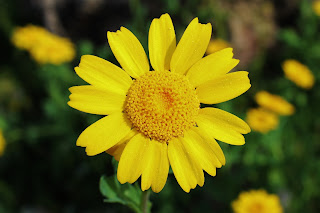 Glebionis segetum (syn. Chrysanthemum segetum) is a species of the genus Glebionis, probably native only to the eastern Mediterranean region but now naturalized in western and northern Europe as well as China and parts of North America. Common names include corn marigold and corn daisy.
Glebionis segetum (syn. Chrysanthemum segetum) is a species of the genus Glebionis, probably native only to the eastern Mediterranean region but now naturalized in western and northern Europe as well as China and parts of North America. Common names include corn marigold and corn daisy. Glebionis segetum is a herbaceous perennial plant growing to 80 cm tall, with spirally arranged, deeply lobed leaves 5–20 cm long. The flowers are bright yellow, produced in capitulae (flowerheads) 3.5-5.5 cm in diameter, with a ring of ray florets and a centre of disc florets.
Glebionis segetum is a herbaceous perennial plant growing to 80 cm tall, with spirally arranged, deeply lobed leaves 5–20 cm long. The flowers are bright yellow, produced in capitulae (flowerheads) 3.5-5.5 cm in diameter, with a ring of ray florets and a centre of disc florets.Glebionis segetum is widely naturalised outside of its native range, colonising western and central Europe with early human agriculture; it can be an invasive weed in some areas.
 Glebionis segetum was formerly treated in the genus Chrysanthemum, but under a 1999 decision of the International Botanical Congress, that genus has been redefined with a different circumscription to include the economically important florist's chrysanthemum (now Chrysanthemum indicum).
Glebionis segetum was formerly treated in the genus Chrysanthemum, but under a 1999 decision of the International Botanical Congress, that genus has been redefined with a different circumscription to include the economically important florist's chrysanthemum (now Chrysanthemum indicum).The corn marigold appears to have been a serious weed during the 13th century in Scotland, as suggested by a law of Alexander II which states that if a farmer allows so much as a single plant to produce seed in amongst his crops, then he will be fined a sheep.
In Crete and Greece, the leaves and the tender shoots of a variety called neromantilida (νερομαντηλίδα) are eaten raw in salads or browned in hot olive oil by the locals.
From Wikipedia, the free encyclopedia
Photos Apostolos Antreas 12/3/2016 by George Konstantinou




No comments:
Post a Comment